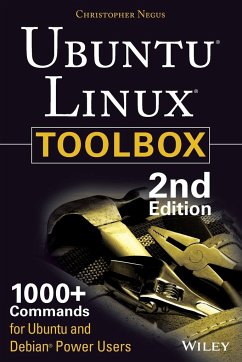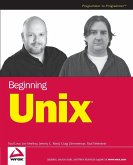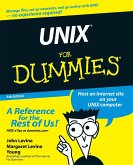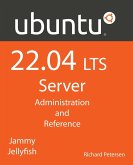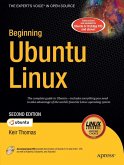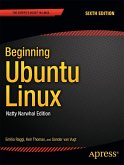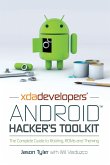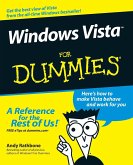Christopher Negus
Ubuntu Linux Toolbox: 1000+ Commands for Power Users
23,99 €
inkl. MwSt.
Versandfertig in über 4 Wochen

12 °P sammeln
Christopher Negus
Ubuntu Linux Toolbox: 1000+ Commands for Power Users
- Broschiertes Buch
- Merkliste
- Auf die Merkliste
- Bewerten Bewerten
- Teilen
- Produkt teilen
- Produkterinnerung
- Produkterinnerung
This updated bestseller from Linux guru Chris Negus is packed with an array of new and revised material
As a longstanding bestseller, Ubuntu Linux Toolbox has taught you how to get the most out Ubuntu, the world's most popular Linux distribution. With this anticipated new edition, Christopher Negus returns with a host of new and expanded coverage on tools for managing file systems, ways to connect to networks, techniques for securing Ubuntu systems, and a look at the latest Long Term Support (LTS) release of Ubuntu, all aimed at getting you up and running with Ubuntu Linux quickly. Covers…mehr
Andere Kunden interessierten sich auch für
![Beginning UNIX Beginning UNIX]() Paul LoveBeginning UNIX34,99 €
Paul LoveBeginning UNIX34,99 €![Unix for Dummies Unix for Dummies]() John R. LevineUnix for Dummies23,99 €
John R. LevineUnix for Dummies23,99 €![Ubuntu 22.04 LTS Server Ubuntu 22.04 LTS Server]() Richard PetersenUbuntu 22.04 LTS Server42,99 €
Richard PetersenUbuntu 22.04 LTS Server42,99 €![Beginning Ubuntu Linux Beginning Ubuntu Linux]() Keir ThomasBeginning Ubuntu Linux30,99 €
Keir ThomasBeginning Ubuntu Linux30,99 €![Beginning Ubuntu Linux Beginning Ubuntu Linux]() Emilio RaggiBeginning Ubuntu Linux46,99 €
Emilio RaggiBeginning Ubuntu Linux46,99 €![Xda Developers' Android Hacker's Toolkit Xda Developers' Android Hacker's Toolkit]() Jason TylerXda Developers' Android Hacker's Toolkit26,99 €
Jason TylerXda Developers' Android Hacker's Toolkit26,99 €![Windows Vista For Dummies Windows Vista For Dummies]() Andy RathboneWindows Vista For Dummies17,99 €
Andy RathboneWindows Vista For Dummies17,99 €-
-
-
This updated bestseller from Linux guru Chris Negus is packed with an array of new and revised material
As a longstanding bestseller, Ubuntu Linux Toolbox has taught you how to get the most out Ubuntu, the world's most popular Linux distribution. With this anticipated new edition, Christopher Negus returns with a host of new and expanded coverage on tools for managing file systems, ways to connect to networks, techniques for securing Ubuntu systems, and a look at the latest Long Term Support (LTS) release of Ubuntu, all aimed at getting you up and running with Ubuntu Linux quickly.
Covers installation, configuration, shell primer, the desktop, administrations, servers, and security
Delves into coverage of popular applications for the web, productivity suites, and e-mail
Highlights setting up a server (Apache, Samba, CUPS)
Boasts a handy trim size so that you can take it with you on the go
Ubuntu Linux Toolbox, Second Edition prepares you with a host of updated tools for today's environment, as well as expanded coverage on everything you know to confidently start using Ubuntu today.
As a longstanding bestseller, Ubuntu Linux Toolbox has taught you how to get the most out Ubuntu, the world's most popular Linux distribution. With this anticipated new edition, Christopher Negus returns with a host of new and expanded coverage on tools for managing file systems, ways to connect to networks, techniques for securing Ubuntu systems, and a look at the latest Long Term Support (LTS) release of Ubuntu, all aimed at getting you up and running with Ubuntu Linux quickly.
Covers installation, configuration, shell primer, the desktop, administrations, servers, and security
Delves into coverage of popular applications for the web, productivity suites, and e-mail
Highlights setting up a server (Apache, Samba, CUPS)
Boasts a handy trim size so that you can take it with you on the go
Ubuntu Linux Toolbox, Second Edition prepares you with a host of updated tools for today's environment, as well as expanded coverage on everything you know to confidently start using Ubuntu today.
Produktdetails
- Produktdetails
- Verlag: Wiley & Sons
- Artikelnr. des Verlages: 1W118183520
- 2. Aufl.
- Seitenzahl: 368
- Erscheinungstermin: 19. August 2013
- Englisch
- Abmessung: 229mm x 152mm x 20mm
- Gewicht: 400g
- ISBN-13: 9781118183526
- ISBN-10: 1118183525
- Artikelnr.: 37150598
- Herstellerkennzeichnung
- Libri GmbH
- Europaallee 1
- 36244 Bad Hersfeld
- gpsr@libri.de
- Verlag: Wiley & Sons
- Artikelnr. des Verlages: 1W118183520
- 2. Aufl.
- Seitenzahl: 368
- Erscheinungstermin: 19. August 2013
- Englisch
- Abmessung: 229mm x 152mm x 20mm
- Gewicht: 400g
- ISBN-13: 9781118183526
- ISBN-10: 1118183525
- Artikelnr.: 37150598
- Herstellerkennzeichnung
- Libri GmbH
- Europaallee 1
- 36244 Bad Hersfeld
- gpsr@libri.de
CHRISTOPHER NEGUS has more than 25 years of experience teaching and writing about Linux and UNIX. He has authored dozens of books on Linux, including the best-selling Red Hat Linux Bible, Linux Bible, the Linux Toys series, and the Linux Toolbox series.Awards for Christopher's writing include "Best Linux book of the year" for his Red Hat Linux 8 Bible, as voted by readers of Linux World magazine. For the Linux Journal 2009 Readers' Choice Awards, his Linux Bible was voted one of the top five "Favorite Linux Books of All Time."
Introduction xix Chapter 1: Starting with Ubuntu Linux 1 Ubuntu, Debian, and Linux 2 Understanding Ubuntu Releases 3 Ubuntu Compared to Other Linux Distributions 3 Finding Ubuntu Resources 5 Ubuntu Software 7 Focusing on Linux Commands 7 Finding Commands 9 Reference Information in Ubuntu 11 Using help Messages 12 Using man Pages 12 Using info Documents 15 Summary 15 Chapter 2: Installing Ubuntu and Adding Software 17 Obtaining and Installing Ubuntu 17 Preparing to Install 18 Choosing Installation Options 19 Answering Installation Questions 19 Working with Debian Software Packages 20 Working with Software Packages 22 Enabling More Repositories for apt 23 Adding Software Collections with tasksel 24 Managing Software with APT 25 Finding Packages with APT 27 Installing Packages with APT 27 Upgrading Packages with APT 28 Upgrading a Single Package with APT 28 Removing Packages with APT 29 Cleaning Up Packages with APT 29 Downloading Packages with APT 30 Managing Software with dpkg 30 Installing a Package with dpkg 32 Removing a Package with dpkg 32 Extracting Files from a .deb File with dpkg 32 Querying Information about .deb Packages 33 Managing Software with aptitude 35 Updating and Upgrading Packages with aptitude 37 Querying Information about Packages with aptitude 37 Installing Packages with aptitude 38 Removing Packages with aptitude 38 Cleaning Up Packages with aptitude 39 Useful Combinations of Options with aptitude 39 Verifying Installed Packages with debsums 41 Building deb Packages 44 Summary 47 Chapter 3: Using the Shell 49 Terminal Windows and Shell Access 49 Using Terminal Windows 49 Using Virtual Consoles 51 Using the Shell 52 Using Bash History 53 Using Command Line Completion 54 Redirecting stdin and stdout 54 Using alias 57 Watching Commands 58 Watching Files 58 Acquiring Super User Power 58 Delegating Power with sudo 59 Using the su Command 61 Using Environment Variables 62 Creating Simple Shell Scripts 64 Editing and Running a Script 64 Adding Content to Your Script 65 Summary 68 Chapter 4: Working with Files 69 Understanding File Types 69 Using Regular Files 69 Using Directories 71 Using Symbolic and Hard Links 71 Using Device Files 72 Using Named Pipes and Sockets 73 Setting File/Directory Permissions 73 Changing Permissions with chmod 74 Setting the umask 76 Changing Ownership 76 Traversing the Filesystem 77 Copying Files 79 Changing File Attributes 80 Searching for Files 82 Finding Files with locate 82 Locating Files with find 83 Using Other Commands to Find Files 85 Finding Out More about Files 86 Listing Files 86 Verifying Files 86 Summary 88 Chapter 5: Manipulating Text 89 Matching Text with Regular Expressions 89 Editing Text Files 90 Using the JOE Editor 91 Using the Pico and nano Editors 92 Graphical Text Editors 94 Listing, Sorting, and Changing Text 94 Listing Text Files 94 Paging through Text 95 Paginating Text Files with pr 96 Searching for Text with grep 97 Replacing Text with sed 99 Translating or Removing Characters with tr 101 Checking Differences between Two Files with diff 101 Using awk and cut to Process Columns 104 Converting Text Files to Different Formats 105 Summary 105 Chapter 6: Playing with Multimedia 107 Working with Audio 107 Playing Music 107 Adjusting Audio Levels 109 Ripping CD Music 110 Encoding Music 111 Streaming Music 114 Converting Audio Files 116 Transforming Images 117 Getting Information about Images 117 Converting Images 118 Converting Images in Batches 119 Playing with Video 121 Playing Video Files 121 Summary 123 Chapter 7: Administering Filesystems 125 Understanding Filesystem Basics 125 Creating and Managing Filesystems 127 Partitioning Hard Disks 127 Working with Filesystem Labels 131 Formatting a Filesystem 132 Viewing and Changing Filesystem Attributes 133 Creating and Using Swap Partitions 135 Mounting and Unmounting Filesystems 136 Mounting Filesystems from the fstab File 136 Mounting Filesystems with the mount Command 138 Unmounting Filesystems with umount 140 Checking Filesystems 141 Creating Encrypted Filesystems 143 Checking RAID Disks 146 Finding Out about Filesystem Use 147 Logical Volume Manager 149 Creating LVM Volumes 149 Using LVM Volumes 151 Growing the LVM Volume 152 Shrinking an LVM Volume 153 Removing LVM Logical Volumes and Groups 153 Summary 154 Chapter 8: Backups and Removable Media 155 Backing Up Data to Compressed Archives 155 Creating Backup Archives with tar 155 Using Compression Tools 157 Listing, Joining, and Adding Files to tar Archives 160 Deleting Files from tar Archives 160 Backing Up over Networks 161 Backing Up tar Archives over ssh 161 Backing Up Files with rsync 162 Backing Up with unison 164 Backing Up to Removable Media 165 Creating Backup Images with mkisofs 165 Burning Backup Images with cdrecord 168 Making and Burning DVDs with growisofs 170 Summary 170 Chapter 9: Checking and Managing Running Processes 171 Listing Active Processes 172 Viewing Active Processes with ps 172 Watching Active Processes with top 177 Finding and Controlling Processes 179 Using pgrep to Find Processes 179 Using fuser to Find Processes 180 Changing Running Processes 181 Scheduling Realtime Processes 188 Summary 189 Chapter 10: Managing the System 191 Monitoring Resources 191 Monitoring Memory Use 192 Monitoring CPU Usage 196 Monitoring Storage Devices 198 Mastering Time 201 Changing Time/Date with Graphical Tools 201 Displaying and Setting Your System Clock 202 Displaying and Setting Your Hardware Clock 203 Using Network Time Protocol to Set Date/Time 204 Managing the Boot Process 205 Understanding the GRUB Boot Loader 205 Modifying the GRUB Boot Loader 206 Controlling Startup and Run Levels 207 Straight to the Kernel 209 Poking at the Hardware 211 Summary 213 Chapter 11: Managing Network Connections 215 Configuring Networks from the GUI 215 Managing Network Interface Cards 216 Managing Network Connections 221 Starting and Stopping Ethernet Connections 221 Viewing Ethernet Connection Information 223 Using Wireless Connections 225 Checking Name Resolution 226 Troubleshooting Network Problems 228 Checking Connectivity to a Host 228 Checking Address Resolution Protocol 229 Tracing Routes to Hosts 231 Displaying netstat Connections and Statistics 233 Other Useful Network Tools 234 Summary 235 Chapter 12: Accessing Network Resources 237 Running Commands to Browse the Web 237 Transferring Files 239 Downloading Files with wget 239 Transferring Files with cURL 241 Transferring Files with FTP Commands 241 Using SSH Tools to Transfer Files 243 Using Windows File Transfer Tools 246 Sharing Remote Directories 246 Sharing Remote Directories with NFS 246 Sharing Remote Directories with Samba 248 Sharing Remote Directories with SSHFS 251 Chatting with Friends in IRC 252 Using Text-Based E
mail Clients 253 Managing E
mail with mail 254 Managing E
mail with mutt 256 Summary 257 Chapter 13: Doing Remote System Administration 259 Doing Remote Login and Tunneling with SSH 259 Using Legacy Communications Tools 260 Configuring SSH 261 Logging in Remotely with ssh 262 Using byobu and screen for Remote Shells 267 Managing Remote Shells with Screen 268 Using byobu to Manage Remote Shells 270 Using a Remote Windows Desktop 272 Connecting to a Windows Desktop with Remmina 272 Connecting to a Windows Desktop with rdesktop 274 Using Remote Linux Desktop and Applications 274 Sharing Desktops Using VNC 275 Setting Up the VNC Server 276 Starting Up the VNC Client 277 Using VNC on Untrusted Networks with SSH 277 Summary 278 Chapter 14: Locking Down Security 279 Working with Users and Groups 279 Managing Users the GUI Way 280 Adding User Accounts 280 Changing useradd Defaults 281 Modifying User Accounts 282 Deleting User Accounts 283 Managing Passwords 283 Adding Groups 286 Checking on Users 286 Configuring the Built-In Firewall 288 Understanding iptables Firewalls 289 Listing iptables Rules 291 Setting Other Firewall Rules 292 Saving and Reloading Firewall Rules 294 Using Advanced Security Features 294 Summary 295 Chapter 15: Setting Up a Virtualization Host and Virtual Machines 297 Can Your Computer Support Virtualization? 298 Checking for CPU Virtualization Support 298 Enabling Virtualization Support in the BIOS 299 Is the Host Computer 32- or 64-Bit? 300 Checking Available RAM and Disk Space 300 Adding Virtualization Software 301 Adding Your User Account to libvirtd 302 Managing Virtual Machines with virt-manager 302 Creating a Virtual Machine in virt-manager 304 Starting and Stopping Virtual Machines with virt-manager 305 Managing Virtual Machines with Commands 306 Creating a Virtual Machine with virt-install 306 Starting and Stopping Virtual Machines with virsh 308 Summary 309 Appendix A: Using vi or Vim Editors 311 Starting and Quitting the vi Editor 311 Moving Around in vi 313 Changing and Deleting Text in vi 314 Using Miscellaneous Commands 314 Modifying Commands with Numbers 315 Using ex Commands 315 Working in Visual Mode 316 Appendix B: Shell Special Characters and Variables 317 Using Special Shell Characters 317 Using Shell Variables 318 Appendix C: Getting Information from /proc 321 Viewing /proc Information 321 Changing /proc Information 325 Index 327
mail Clients 253 Managing E
mail with mail 254 Managing E
mail with mutt 256 Summary 257 Chapter 13: Doing Remote System Administration 259 Doing Remote Login and Tunneling with SSH 259 Using Legacy Communications Tools 260 Configuring SSH 261 Logging in Remotely with ssh 262 Using byobu and screen for Remote Shells 267 Managing Remote Shells with Screen 268 Using byobu to Manage Remote Shells 270 Using a Remote Windows Desktop 272 Connecting to a Windows Desktop with Remmina 272 Connecting to a Windows Desktop with rdesktop 274 Using Remote Linux Desktop and Applications 274 Sharing Desktops Using VNC 275 Setting Up the VNC Server 276 Starting Up the VNC Client 277 Using VNC on Untrusted Networks with SSH 277 Summary 278 Chapter 14: Locking Down Security 279 Working with Users and Groups 279 Managing Users the GUI Way 280 Adding User Accounts 280 Changing useradd Defaults 281 Modifying User Accounts 282 Deleting User Accounts 283 Managing Passwords 283 Adding Groups 286 Checking on Users 286 Configuring the Built-In Firewall 288 Understanding iptables Firewalls 289 Listing iptables Rules 291 Setting Other Firewall Rules 292 Saving and Reloading Firewall Rules 294 Using Advanced Security Features 294 Summary 295 Chapter 15: Setting Up a Virtualization Host and Virtual Machines 297 Can Your Computer Support Virtualization? 298 Checking for CPU Virtualization Support 298 Enabling Virtualization Support in the BIOS 299 Is the Host Computer 32- or 64-Bit? 300 Checking Available RAM and Disk Space 300 Adding Virtualization Software 301 Adding Your User Account to libvirtd 302 Managing Virtual Machines with virt-manager 302 Creating a Virtual Machine in virt-manager 304 Starting and Stopping Virtual Machines with virt-manager 305 Managing Virtual Machines with Commands 306 Creating a Virtual Machine with virt-install 306 Starting and Stopping Virtual Machines with virsh 308 Summary 309 Appendix A: Using vi or Vim Editors 311 Starting and Quitting the vi Editor 311 Moving Around in vi 313 Changing and Deleting Text in vi 314 Using Miscellaneous Commands 314 Modifying Commands with Numbers 315 Using ex Commands 315 Working in Visual Mode 316 Appendix B: Shell Special Characters and Variables 317 Using Special Shell Characters 317 Using Shell Variables 318 Appendix C: Getting Information from /proc 321 Viewing /proc Information 321 Changing /proc Information 325 Index 327
Introduction xix Chapter 1: Starting with Ubuntu Linux 1 Ubuntu, Debian, and Linux 2 Understanding Ubuntu Releases 3 Ubuntu Compared to Other Linux Distributions 3 Finding Ubuntu Resources 5 Ubuntu Software 7 Focusing on Linux Commands 7 Finding Commands 9 Reference Information in Ubuntu 11 Using help Messages 12 Using man Pages 12 Using info Documents 15 Summary 15 Chapter 2: Installing Ubuntu and Adding Software 17 Obtaining and Installing Ubuntu 17 Preparing to Install 18 Choosing Installation Options 19 Answering Installation Questions 19 Working with Debian Software Packages 20 Working with Software Packages 22 Enabling More Repositories for apt 23 Adding Software Collections with tasksel 24 Managing Software with APT 25 Finding Packages with APT 27 Installing Packages with APT 27 Upgrading Packages with APT 28 Upgrading a Single Package with APT 28 Removing Packages with APT 29 Cleaning Up Packages with APT 29 Downloading Packages with APT 30 Managing Software with dpkg 30 Installing a Package with dpkg 32 Removing a Package with dpkg 32 Extracting Files from a .deb File with dpkg 32 Querying Information about .deb Packages 33 Managing Software with aptitude 35 Updating and Upgrading Packages with aptitude 37 Querying Information about Packages with aptitude 37 Installing Packages with aptitude 38 Removing Packages with aptitude 38 Cleaning Up Packages with aptitude 39 Useful Combinations of Options with aptitude 39 Verifying Installed Packages with debsums 41 Building deb Packages 44 Summary 47 Chapter 3: Using the Shell 49 Terminal Windows and Shell Access 49 Using Terminal Windows 49 Using Virtual Consoles 51 Using the Shell 52 Using Bash History 53 Using Command Line Completion 54 Redirecting stdin and stdout 54 Using alias 57 Watching Commands 58 Watching Files 58 Acquiring Super User Power 58 Delegating Power with sudo 59 Using the su Command 61 Using Environment Variables 62 Creating Simple Shell Scripts 64 Editing and Running a Script 64 Adding Content to Your Script 65 Summary 68 Chapter 4: Working with Files 69 Understanding File Types 69 Using Regular Files 69 Using Directories 71 Using Symbolic and Hard Links 71 Using Device Files 72 Using Named Pipes and Sockets 73 Setting File/Directory Permissions 73 Changing Permissions with chmod 74 Setting the umask 76 Changing Ownership 76 Traversing the Filesystem 77 Copying Files 79 Changing File Attributes 80 Searching for Files 82 Finding Files with locate 82 Locating Files with find 83 Using Other Commands to Find Files 85 Finding Out More about Files 86 Listing Files 86 Verifying Files 86 Summary 88 Chapter 5: Manipulating Text 89 Matching Text with Regular Expressions 89 Editing Text Files 90 Using the JOE Editor 91 Using the Pico and nano Editors 92 Graphical Text Editors 94 Listing, Sorting, and Changing Text 94 Listing Text Files 94 Paging through Text 95 Paginating Text Files with pr 96 Searching for Text with grep 97 Replacing Text with sed 99 Translating or Removing Characters with tr 101 Checking Differences between Two Files with diff 101 Using awk and cut to Process Columns 104 Converting Text Files to Different Formats 105 Summary 105 Chapter 6: Playing with Multimedia 107 Working with Audio 107 Playing Music 107 Adjusting Audio Levels 109 Ripping CD Music 110 Encoding Music 111 Streaming Music 114 Converting Audio Files 116 Transforming Images 117 Getting Information about Images 117 Converting Images 118 Converting Images in Batches 119 Playing with Video 121 Playing Video Files 121 Summary 123 Chapter 7: Administering Filesystems 125 Understanding Filesystem Basics 125 Creating and Managing Filesystems 127 Partitioning Hard Disks 127 Working with Filesystem Labels 131 Formatting a Filesystem 132 Viewing and Changing Filesystem Attributes 133 Creating and Using Swap Partitions 135 Mounting and Unmounting Filesystems 136 Mounting Filesystems from the fstab File 136 Mounting Filesystems with the mount Command 138 Unmounting Filesystems with umount 140 Checking Filesystems 141 Creating Encrypted Filesystems 143 Checking RAID Disks 146 Finding Out about Filesystem Use 147 Logical Volume Manager 149 Creating LVM Volumes 149 Using LVM Volumes 151 Growing the LVM Volume 152 Shrinking an LVM Volume 153 Removing LVM Logical Volumes and Groups 153 Summary 154 Chapter 8: Backups and Removable Media 155 Backing Up Data to Compressed Archives 155 Creating Backup Archives with tar 155 Using Compression Tools 157 Listing, Joining, and Adding Files to tar Archives 160 Deleting Files from tar Archives 160 Backing Up over Networks 161 Backing Up tar Archives over ssh 161 Backing Up Files with rsync 162 Backing Up with unison 164 Backing Up to Removable Media 165 Creating Backup Images with mkisofs 165 Burning Backup Images with cdrecord 168 Making and Burning DVDs with growisofs 170 Summary 170 Chapter 9: Checking and Managing Running Processes 171 Listing Active Processes 172 Viewing Active Processes with ps 172 Watching Active Processes with top 177 Finding and Controlling Processes 179 Using pgrep to Find Processes 179 Using fuser to Find Processes 180 Changing Running Processes 181 Scheduling Realtime Processes 188 Summary 189 Chapter 10: Managing the System 191 Monitoring Resources 191 Monitoring Memory Use 192 Monitoring CPU Usage 196 Monitoring Storage Devices 198 Mastering Time 201 Changing Time/Date with Graphical Tools 201 Displaying and Setting Your System Clock 202 Displaying and Setting Your Hardware Clock 203 Using Network Time Protocol to Set Date/Time 204 Managing the Boot Process 205 Understanding the GRUB Boot Loader 205 Modifying the GRUB Boot Loader 206 Controlling Startup and Run Levels 207 Straight to the Kernel 209 Poking at the Hardware 211 Summary 213 Chapter 11: Managing Network Connections 215 Configuring Networks from the GUI 215 Managing Network Interface Cards 216 Managing Network Connections 221 Starting and Stopping Ethernet Connections 221 Viewing Ethernet Connection Information 223 Using Wireless Connections 225 Checking Name Resolution 226 Troubleshooting Network Problems 228 Checking Connectivity to a Host 228 Checking Address Resolution Protocol 229 Tracing Routes to Hosts 231 Displaying netstat Connections and Statistics 233 Other Useful Network Tools 234 Summary 235 Chapter 12: Accessing Network Resources 237 Running Commands to Browse the Web 237 Transferring Files 239 Downloading Files with wget 239 Transferring Files with cURL 241 Transferring Files with FTP Commands 241 Using SSH Tools to Transfer Files 243 Using Windows File Transfer Tools 246 Sharing Remote Directories 246 Sharing Remote Directories with NFS 246 Sharing Remote Directories with Samba 248 Sharing Remote Directories with SSHFS 251 Chatting with Friends in IRC 252 Using Text-Based E
mail Clients 253 Managing E
mail with mail 254 Managing E
mail with mutt 256 Summary 257 Chapter 13: Doing Remote System Administration 259 Doing Remote Login and Tunneling with SSH 259 Using Legacy Communications Tools 260 Configuring SSH 261 Logging in Remotely with ssh 262 Using byobu and screen for Remote Shells 267 Managing Remote Shells with Screen 268 Using byobu to Manage Remote Shells 270 Using a Remote Windows Desktop 272 Connecting to a Windows Desktop with Remmina 272 Connecting to a Windows Desktop with rdesktop 274 Using Remote Linux Desktop and Applications 274 Sharing Desktops Using VNC 275 Setting Up the VNC Server 276 Starting Up the VNC Client 277 Using VNC on Untrusted Networks with SSH 277 Summary 278 Chapter 14: Locking Down Security 279 Working with Users and Groups 279 Managing Users the GUI Way 280 Adding User Accounts 280 Changing useradd Defaults 281 Modifying User Accounts 282 Deleting User Accounts 283 Managing Passwords 283 Adding Groups 286 Checking on Users 286 Configuring the Built-In Firewall 288 Understanding iptables Firewalls 289 Listing iptables Rules 291 Setting Other Firewall Rules 292 Saving and Reloading Firewall Rules 294 Using Advanced Security Features 294 Summary 295 Chapter 15: Setting Up a Virtualization Host and Virtual Machines 297 Can Your Computer Support Virtualization? 298 Checking for CPU Virtualization Support 298 Enabling Virtualization Support in the BIOS 299 Is the Host Computer 32- or 64-Bit? 300 Checking Available RAM and Disk Space 300 Adding Virtualization Software 301 Adding Your User Account to libvirtd 302 Managing Virtual Machines with virt-manager 302 Creating a Virtual Machine in virt-manager 304 Starting and Stopping Virtual Machines with virt-manager 305 Managing Virtual Machines with Commands 306 Creating a Virtual Machine with virt-install 306 Starting and Stopping Virtual Machines with virsh 308 Summary 309 Appendix A: Using vi or Vim Editors 311 Starting and Quitting the vi Editor 311 Moving Around in vi 313 Changing and Deleting Text in vi 314 Using Miscellaneous Commands 314 Modifying Commands with Numbers 315 Using ex Commands 315 Working in Visual Mode 316 Appendix B: Shell Special Characters and Variables 317 Using Special Shell Characters 317 Using Shell Variables 318 Appendix C: Getting Information from /proc 321 Viewing /proc Information 321 Changing /proc Information 325 Index 327
mail Clients 253 Managing E
mail with mail 254 Managing E
mail with mutt 256 Summary 257 Chapter 13: Doing Remote System Administration 259 Doing Remote Login and Tunneling with SSH 259 Using Legacy Communications Tools 260 Configuring SSH 261 Logging in Remotely with ssh 262 Using byobu and screen for Remote Shells 267 Managing Remote Shells with Screen 268 Using byobu to Manage Remote Shells 270 Using a Remote Windows Desktop 272 Connecting to a Windows Desktop with Remmina 272 Connecting to a Windows Desktop with rdesktop 274 Using Remote Linux Desktop and Applications 274 Sharing Desktops Using VNC 275 Setting Up the VNC Server 276 Starting Up the VNC Client 277 Using VNC on Untrusted Networks with SSH 277 Summary 278 Chapter 14: Locking Down Security 279 Working with Users and Groups 279 Managing Users the GUI Way 280 Adding User Accounts 280 Changing useradd Defaults 281 Modifying User Accounts 282 Deleting User Accounts 283 Managing Passwords 283 Adding Groups 286 Checking on Users 286 Configuring the Built-In Firewall 288 Understanding iptables Firewalls 289 Listing iptables Rules 291 Setting Other Firewall Rules 292 Saving and Reloading Firewall Rules 294 Using Advanced Security Features 294 Summary 295 Chapter 15: Setting Up a Virtualization Host and Virtual Machines 297 Can Your Computer Support Virtualization? 298 Checking for CPU Virtualization Support 298 Enabling Virtualization Support in the BIOS 299 Is the Host Computer 32- or 64-Bit? 300 Checking Available RAM and Disk Space 300 Adding Virtualization Software 301 Adding Your User Account to libvirtd 302 Managing Virtual Machines with virt-manager 302 Creating a Virtual Machine in virt-manager 304 Starting and Stopping Virtual Machines with virt-manager 305 Managing Virtual Machines with Commands 306 Creating a Virtual Machine with virt-install 306 Starting and Stopping Virtual Machines with virsh 308 Summary 309 Appendix A: Using vi or Vim Editors 311 Starting and Quitting the vi Editor 311 Moving Around in vi 313 Changing and Deleting Text in vi 314 Using Miscellaneous Commands 314 Modifying Commands with Numbers 315 Using ex Commands 315 Working in Visual Mode 316 Appendix B: Shell Special Characters and Variables 317 Using Special Shell Characters 317 Using Shell Variables 318 Appendix C: Getting Information from /proc 321 Viewing /proc Information 321 Changing /proc Information 325 Index 327
